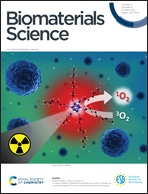CaO2/gelatin oxygen slow-releasing microspheres facilitate tissue engineering efficiency for the osteonecrosis of femoral head by enhancing the angiogenesis and survival of grafted bone marrow mesenchymal stem cells
Abstract
The osteonecrosis of femoral head (ONFH), a common refractory disease, is still not fully understood today. Hypoxia caused by ischemia is not only an important pathogenic factor but also a critical challenge for the survival of seed cells in the tissue engineering therapy of ONFH. To explore an efficient strategy to treat ONFH by targeting hypoxia, newly designed CaO2/gelatin microspheres were composited with 3D printed polycaprolactone/nano-hydroxyapatite (PCL/nHA) porous scaffold, sodium alginate/gelatin hydrogel, and bone marrow mesenchymal stem cells (BMSCs) to develop a novel tissue engineering scaffold and then transplanted into the core depression area of the ONFH rabbit model. The current data demonstrated that CaO2/gelatin microspheres can constantly release oxygen for 19 days. In vitro assays with BMSCs illustrated that scaffolds have high biocompatibility and are favorable for cell proliferation in extreme hypoxia (1% O2). The in vivo study demonstrated that the transplanted scaffold with oxygen-generating microspheres significantly enhanced the osteogenic and angiogenic effects compared to the scaffold without microspheres. Further assessments revealed that microspheres in the scaffold can reduce the local cell apoptosis and enhance the survival of grafted cells in the host. Collectively, the present study developed a novel oxygen slow-releasing composite scaffold, which can facilitate tissue engineering efficiency for treating the osteonecrosis of the femoral head by enhancing the angiogenesis and survival of grafted stem cells.



 Please wait while we load your content...
Please wait while we load your content...